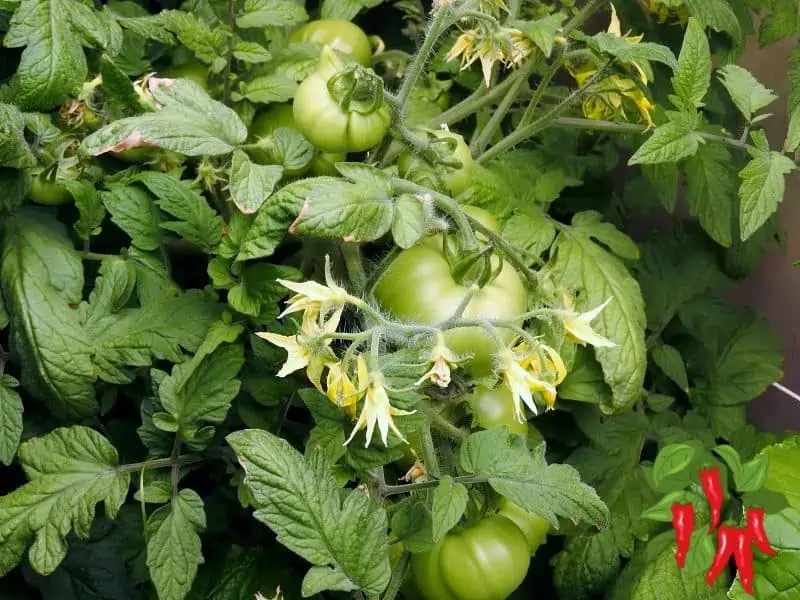This post may contain affiliate links. If you buy something from one of our links we may earn a commission. Thanks
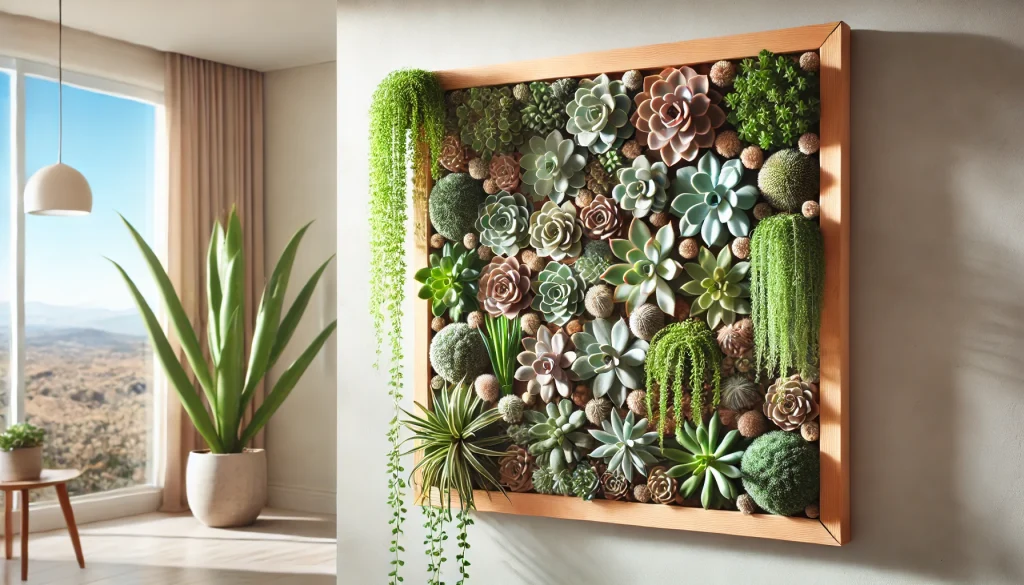
Vertical Succulent Gardens: Easy DIY Ideas
If you’re tight on space but love gardening, vertical succulent gardens might just be your new best friend.
They’re space-saving, low-maintenance, and add a lovely splash of greenery to any indoor area.
Let’s dive into some easy DIY ideas to get your vertical succulent garden started and thriving.
Vertical Succulent Gardens Key Takeaways
- Vertical Succulent Gardens are perfect for saving space and adding greenery indoors.
- Create your own by using a shallow frame with wire mesh, filling it with well-draining soil, and planting succulents securely.
- Enjoy a beautiful, low-maintenance garden that enhances any room.
1. 15 Popular Succulents for Vertical Gardens
Starting with a list of popular succulents sets a strong foundation for your vertical garden. These plants are not only beautiful but also well-suited for vertical arrangements. Here are some excellent choices:
Burro’s Tail (Sedum morganianum)
Burro’s Tail is known for its trailing stems covered in small, fleshy leaves. It’s perfect for hanging planters and adds a cascading effect to your garden.
String of Pearls (Senecio rowleyanus)
This succulent features long, trailing stems with bead-like leaves. It’s a striking plant that adds a unique texture to your vertical garden.
Hen and Chicks (Sempervivum tectorum)
Hen and Chicks form rosettes of fleshy leaves and produce offsets, or “chicks,” around the mother plant. They’re hardy and can thrive in various conditions.
Zebra Plant (Haworthia fasciata)
Zebra Plant has dark green leaves with white stripes, resembling a zebra’s pattern. It’s compact and works well in small spaces.
Jade Plant (Crassula ovata)
Jade Plant is a popular succulent with thick, shiny leaves. It’s easy to care for and can live for many years, making it a great addition to your vertical garden.
Echeveria (Echeveria elegans)
Echeveria forms beautiful rosettes and comes in various colors and shapes. It’s a favorite among succulent enthusiasts and adds a touch of elegance to your garden.
Aloe Vera (Aloe barbadensis miller)
Aloe Vera is not only a useful medicinal plant but also a striking succulent with its long, pointed leaves. It thrives in bright light and well-draining soil.
String of Hearts (Ceropegia woodii)
String of Hearts has delicate, heart-shaped leaves on long, trailing stems. It’s perfect for adding a whimsical touch to your vertical garden.
Panda Plant (Kalanchoe tomentosa)
Panda Plant is known for its fuzzy, gray-green leaves edged in brown. It’s easy to grow and adds a unique texture to your succulent collection.
Ghost Plant (Graptopetalum paraguayense)
Ghost Plant has pale, bluish-gray leaves that form rosettes. It’s a hardy succulent that can tolerate a variety of growing conditions.
Donkey’s Tail (Sedum burrito)
Similar to Burro’s Tail, Donkey’s Tail has trailing stems with fleshy, blue-green leaves. It’s ideal for hanging baskets and adds a lush, cascading look.
Flaming Katy (Kalanchoe blossfeldiana)
 Flaming Katy produces bright, colorful flowers that last for weeks. It’s a cheerful addition to any vertical garden, adding both color and texture.
Flaming Katy produces bright, colorful flowers that last for weeks. It’s a cheerful addition to any vertical garden, adding both color and texture.
Pincushion Cactus (Mammillaria)
Pincushion Cactus is a small, round cactus covered in spines. It adds an interesting contrast to the soft leaves of other succulents.
Crown of Thorns (Euphorbia milii)
Crown of Thorns is a unique succulent with spiky stems and vibrant flowers. It’s hardy and can thrive in less-than-ideal conditions.
Sedum (Sedum reflexum)
Sedum is a versatile succulent with small, needle-like leaves. It’s tough and adaptable, making it perfect for vertical gardens.
With these popular succulents, you can create a stunning vertical garden that’s both beautiful and easy to maintain. Let’s move on to the DIY guide to get your garden started.
2. Vertical Succulent Garden DIY
Creating a vertical succulent garden is a fun and rewarding project. You don’t need a lot of materials, and it’s a great way to recycle items you might already have. Here’s a step-by-step guide to get you going.
Materials Needed:
- Shallow Wooden Boxes or Frames: Look for something around 2 inches deep to provide enough room for the roots.
- Wire Mesh or Hardware Cloth: This helps hold the soil and plants in place.
- Plastic Sheet or Landscape Cloth for the back of the frame.
- Succulent-Specific Soil Mix: Ensure it’s well-draining to prevent root rot.
- Succulent Plants and Cuttings: Use a variety of succulents for an attractive display.
- Basic Tools: Scissors, utility knife, nails, hammer, and possibly a staple gun.
Step-by-Step Guide:
1. Building the Frame:
- Choose the Right Box or Frame: Opt for a shallow wooden box, around 2 inches deep. This depth is ideal for succulent roots.
- Attach the Wire Mesh: Secure the wire mesh to the front of the frame using nails or a staple gun. The mesh will hold the soil and plants in place. Ensure it’s tightly attached to prevent any soil from escaping.
2. Preparing the Frame:
- Seal the Wood: Apply a coat of exterior paint or sealant to protect the wood from moisture. This step helps prolong the life of your frame, especially if it’s placed in a humid environment.
- Allow to Dry: Make sure the sealant or paint is completely dry before moving on to the next step.
- Staple on the Backing: Use plastic or acrylic sheet, or landscape cloth.
3. Filling with Soil:
- Choose the Right Soil: Use a succulent-specific soil mix that ensures good drainage. This type of soil prevents water from accumulating, which can cause root rot.
- Fill the Frame: Add the soil mix to the frame, making sure it’s evenly distributed. Press the soil down lightly to compact it and prevent it from settling too much after watering.
4. Planting Succulents:
- Plan Your Layout: Before planting, lay out your succulents on top of the soil to determine the best arrangement. Consider mixing different shapes, sizes, and colors for visual interest.
- Create Planting Holes: Use a utility knife to create small holes in the wire mesh where each succulent will go. Make sure the holes are just big enough for the roots to fit through.
- Insert the Plants: Carefully insert the roots of each succulent through the holes in the mesh and into the soil. Press the soil around the roots to secure the plants in place.
- Allow Space for Growth: Ensure that each plant has enough space to grow. Succulents can spread out over time, so don’t overcrowd them.
5. Final Touches:
- Water Sparingly: After planting, wait a few days before watering to let the roots settle. When you do water, do so sparingly. Succulents need less water than other plants, and overwatering can lead to rot.
- Find the Right Spot: Place your vertical garden in a spot with adequate light. Most succulents need bright, indirect sunlight to thrive.
- Monitor and Maintain: Keep an eye on your garden for any signs of distress, such as yellowing leaves or wilting. Adjust your care routine as needed to keep your succulents healthy.
Creating your vertical succulent garden is a rewarding project that brings life and greenery to any space. Enjoy the process, and watch your garden flourish!
3. Vertical Succulent Garden Ideas
There are many creative ways to design your vertical succulent garden. Here are a few ideas to inspire you:
Creative Arrangements:
Frame of Art
Use an old wooden frame and fill it with succulents to create a living artwork. Hang it on a wall to add a touch of greenery to your decor.
Shoe Organizer Garden
Repurpose a fabric shoe organizer by filling its pockets with soil and planting succulents. Hang it on a wall or the back of a door for an easy and accessible vertical garden.
Ladder Display
Lean an old wooden ladder against a wall and attach pots or containers to the steps. This creates a tiered effect and adds height to your garden.
Living Succulent Wreath
Make a wreath using a wire frame and various succulent cuttings. This unique display can be hung on doors, walls, or used as a centerpiece.
Stacked Planters
Use stacked planters to create a multi-level vertical garden. Arrange several planters of different sizes on top of each other, and plant succulents in each level.
This setup is great for small spaces and adds a layered look to your garden.
These creative arrangements can transform any space into a lush, green oasis. Let your imagination run wild and customize your vertical succulent garden to fit your style and space.
4. How to Make a Vertical Succulent Garden
Choosing the right plants and understanding their needs is crucial for a thriving garden. Here’s how to ensure your vertical succulent garden flourishes.
Choosing the Right Plants
Light Conditions Matching your succulents to the light conditions of their new home is essential. Here’s how to do it:
- Sun-Loving Succulents: Types like Echeverias and Sedums thrive in bright light. These plants need several hours of direct sunlight each day to maintain their vibrant colors and healthy growth.
- Shade-Tolerant Succulents: Varieties such as Haworthias and Gasterias can do well in lower light conditions. They are ideal for spots that receive indirect light or partial shade.
Shapes and Textures Creating a visually appealing display involves mixing and matching different shapes and textures:
- Contrasting Shapes: Combine succulents with varying shapes like the rosettes of Echeverias with the trailing stems of String of Pearls. This adds depth and interest to your garden.
- Diverse Textures: Use plants with different textures, such as the smooth leaves of a Jade Plant contrasted with the fuzzy leaves of a Panda Plant. This variety can make your garden more engaging and aesthetically pleasing.
Step-by-Step Guide
1. Building the Frame:
- Choose the Right Box or Frame: Select a shallow wooden box or frame, around 2 inches deep. This depth is ideal for succulent roots.
- Attach the Wire Mesh: Secure the wire mesh to the front of the frame using nails or a staple gun. The mesh will hold the soil and plants in place. Ensure it’s tightly attached to prevent any soil from escaping.
2. Preparing the Frame:
- Seal the Wood: Apply a coat of exterior paint or sealant to protect the wood from moisture. This step helps prolong the life of your frame, especially if it’s placed in a humid environment.
- Allow to Dry: Make sure the sealant or paint is completely dry before moving on to the next step.
- Attach Backing: Add a sheet of acrylic or use heavy plastic sheeting to the back of the frame to hold the soil in.
3. Filling with Soil:
- Choose the Right Soil: Use a succulent-specific soil mix that ensures good drainage. This type of soil prevents water from accumulating, which can cause root rot.
- Fill the Frame: Add the soil mix to the frame, making sure it’s evenly distributed. Press the soil down lightly to compact it and prevent it from settling too much after watering.
4. Planting Succulents:
- Plan Your Layout: Before planting, lay out your succulents on top of the soil to determine the best arrangement. Consider mixing different shapes, sizes, and colors for visual interest.
- Create Planting Holes: Use a utility knife to create small holes in the wire mesh where each succulent will go. Make sure the holes are just big enough for the roots to fit through.
- Insert the Plants: Carefully insert the roots of each succulent through the holes in the mesh and into the soil. Press the soil around the roots to secure the plants in place.
- Allow Space for Growth: Ensure that each plant has enough space to grow. Succulents can spread out over time, so don’t overcrowd them.
5. Final Touches:
- Water Sparingly: After planting, wait a few days before watering to let the roots settle. When you do water, do so sparingly. Succulents need less water than other plants, and overwatering can lead to rot.
- Find the Right Spot: Place your vertical garden in a spot with adequate light. Most succulents need bright, indirect sunlight to thrive.
- Monitor and Maintain: Keep an eye on your garden for any signs of distress, such as yellowing leaves or wilting. Adjust your care routine as needed to keep your succulents healthy.
By choosing the right plants and providing them with the conditions they need, you can create a thriving vertical succulent garden that adds beauty and greenery to your space.
Enjoy watching your garden flourish!
5. How to Plant Succulents Vertically
Planting succulents in a vertical garden requires a bit of preparation and careful handling to ensure they thrive.
Here’s how to get your succulents securely planted in your vertical garden:
Detailed Planting Instructions:
1. Preparing Cuttings: Before planting, it’s essential to prepare your succulent cuttings properly. Here’s how:
- Select Healthy Cuttings: Choose healthy, mature cuttings from your succulents. Avoid using cuttings with signs of disease or damage.
- Allow to Callous Over: Place the cuttings in a dry, shaded area for a day or two. This drying period allows the cut ends to callous over, which helps prevent rot once they are planted. Callousing forms a protective layer over the cut end.
2. Preparing the Soil and Frame: While your cuttings are drying, prepare your vertical garden frame and soil:
- Fill with Soil: Ensure your frame is filled with a well-draining succulent soil mix. Lightly compact the soil to provide a stable base for the plants.
- Moisten the Soil: Slightly moisten the soil to make it easier to insert the cuttings. Be careful not to overwater.
3. Planting Techniques: Now that your cuttings are ready, it’s time to plant them:
- Create Planting Holes: Using a utility knife or small garden tool, make small holes in the wire mesh where each succulent will go. The holes should be just big enough for the roots or base of the cuttings to fit through.
- Insert the Cuttings: Gently push the calloused end of each cutting through the holes in the mesh and into the soil. Ensure that the cuttings are inserted deeply enough to be stable but not so deep that they are buried.
- Secure the Cuttings: Press the soil around the base of each cutting to secure it in place. This helps the cuttings stay upright and stable as they begin to root.
4. Spacing and Arrangement: Proper spacing and arrangement are crucial for the growth and aesthetic appeal of your vertical garden:
- Space Evenly: Ensure that each cutting has enough space to grow and expand. Overcrowding can lead to competition for resources and poor air circulation.
- Design Considerations: Arrange your succulents in a pattern that is visually appealing. Consider mixing different shapes, sizes, and colors to create an interesting display.
5. Aftercare: Taking care of your newly planted succulents is vital to their success:
- Initial Watering: Wait a few days after planting before watering to let the cuttings settle and start forming roots. When you do water, do so sparingly.
- Monitor Growth: Keep an eye on your succulents for signs of distress, such as yellowing or wilting leaves. Adjust your care routine as needed, ensuring they get enough light and are not overwatered.
- Regular Maintenance: Trim any dead or damaged leaves and rotate the garden occasionally to ensure even light exposure.
By following these steps, you can securely plant your succulents in a vertical garden, creating a beautiful and thriving display.
Enjoy watching your plants grow and transform your space with their unique charm!
6. Vertical Succulent Gardens Indoor
Indoor vertical succulent gardens are perfect for adding greenery to any room.
They are especially beneficial for small spaces where horizontal gardening isn’t feasible.
Here are some tips to help you create and maintain a beautiful indoor vertical succulent garden:
Indoor-Specific Tips
Lighting: Providing adequate light is crucial for keeping your succulents healthy indoors. Here’s how to ensure your plants get the right amount of light:
- Natural Light: Place your vertical garden near a window that receives plenty of sunlight. South-facing windows are ideal as they provide the most consistent and intense light. Ensure your succulents get at least 4-6 hours of sunlight daily.
- Artificial Light: If natural light is insufficient, consider using grow lights. LED grow lights are energy-efficient and provide the full spectrum of light needed for photosynthesis. Position the lights 6-12 inches above the plants and run them for 12-16 hours daily to mimic natural sunlight.
Maintenance: Keeping your indoor vertical succulent garden healthy requires regular maintenance. Here are some key points to consider:
- Watering: Succulents are drought-tolerant and prefer to dry out between waterings. Overwatering is a common mistake that can lead to root rot. Water your succulents only when the soil is completely dry. Ensure the water drains well to avoid waterlogged soil.
- Pest Control: Indoor plants can attract pests like aphids, mealybugs, and spider mites. Regularly inspect your plants for signs of pests. If you notice any, treat them with a gentle insecticidal soap or neem oil.
- Air Circulation: Good air circulation helps prevent mold and mildew growth. Place a small fan near your vertical garden to promote airflow. Avoid placing your garden in areas with stagnant air, such as corners or enclosed spaces.
- Pruning and Cleaning: Remove any dead or yellowing leaves to keep your garden looking neat and healthy. Pruning also encourages new growth and prevents diseases. Clean the leaves occasionally to remove dust, which can block sunlight and reduce the plant’s ability to photosynthesize.
Additional Tips:
- Temperature and Humidity: Succulents thrive in temperatures between 60-80°F (15-27°C). Avoid placing them near drafty windows or heating vents. Maintain a low humidity level as high humidity can promote fungal diseases.
- Fertilizing: Feed your succulents with a balanced, water-soluble fertilizer diluted to half strength once a month during the growing season (spring and summer). Reduce feeding in the fall and winter when the plants are dormant.
By following these indoor-specific tips, you can create a thriving vertical succulent garden that enhances the aesthetic of any room while providing the joy of gardening in a limited space.
Enjoy the beauty and tranquility that your green oasis brings to your home!
7. Outdoor Vertical Succulent Gardens
Outdoor vertical succulent gardens are a fantastic way to add vibrant greenery to your exterior spaces. They can transform walls, fences, and even patios into lush, living art pieces.
Here are some tips to help you create and maintain a stunning outdoor vertical succulent garden:
Outdoor-Specific Tips
Lighting: Succulents love sunlight, and outdoor settings can provide them with ample light to thrive. Here’s how to optimize lighting for your outdoor vertical garden:
- Sunlight Exposure: Most succulents require full sun for at least 6 hours a day. Place your vertical garden in a sunny spot, such as a south-facing wall, to ensure they receive adequate light.
- Shade Management: In extremely hot climates, provide some afternoon shade to prevent sunburn on your succulents. Use shade cloths or place your garden where it can get filtered sunlight in the afternoon.
Maintenance: Keeping your outdoor vertical succulent garden healthy involves regular care and monitoring. Here are some maintenance tips:
- Watering: Outdoor succulents generally need more frequent watering than indoor ones due to exposure to the elements. Water thoroughly when the soil is completely dry. Ensure your vertical garden has proper drainage to avoid standing water.
- Pest Control: Outdoor plants can attract a variety of pests, including aphids, snails, and caterpillars. Regularly inspect your garden and use appropriate organic or chemical treatments to keep pests at bay.
- Weather Protection: Protect your succulents from extreme weather conditions. During heavy rains, ensure excess water can drain away quickly. In colder climates, consider moving your vertical garden to a sheltered location or covering it during frost.
Additional Tips:
- Soil and Drainage: Use a well-draining soil mix specifically designed for succulents. Make sure your vertical garden setup allows excess water to escape easily to prevent root rot.
- Pruning and Cleaning: Remove any dead or damaged leaves regularly to maintain the health and appearance of your garden. Pruning also helps to promote new growth and prevent overcrowding.
- Fertilizing: Feed your outdoor succulents with a balanced, water-soluble fertilizer diluted to half strength during the growing season. Fertilize every 4-6 weeks in spring and summer, and reduce feeding in the fall and winter.
Creative Arrangements:
Outdoor settings offer unique opportunities for creative vertical garden designs:
- Fence Gardens: Attach planters or pockets to a fence to create a green wall. This is a great way to utilize vertical space in your garden.
- Pallet Gardens: Repurpose wooden pallets by adding soil pockets and planting succulents. Lean the pallet against a wall or fence for a rustic look.
- Living Walls: Install a professional living wall system, which often includes built-in irrigation, to create a more elaborate and permanent vertical garden.
- Repurposed Materials: Use old gutters, pipes, or even shoes to create quirky and unique planters for your succulents.
By following these tips, you can create a thriving outdoor vertical succulent garden that not only beautifies your space but also brings the joy of gardening to new heights.
Enjoy the lush, green backdrop your garden provides, and take pride in your creative and sustainable gardening project!
7. Best Vertical Succulent Gardens Ideas
Here are some standout examples to inspire your vertical gardening journey. These successful setups and creative designs showcase the beauty and versatility of vertical succulent gardens.
Examples of Successful Gardens Ideas
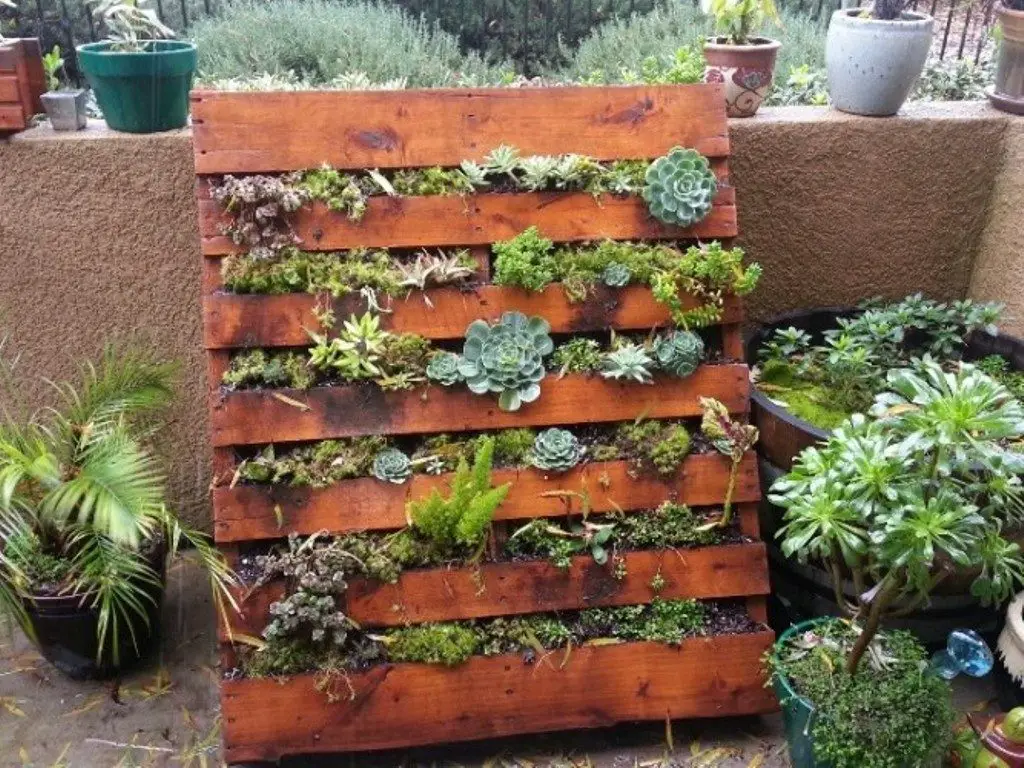
1. DIY Pallet Vertical Garden
A DIY pallet garden can transform an old wooden pallet into a stunning vertical succulent garden.
This project involves adding soil pockets to the pallet’s slats and planting a variety of succulents.
It’s an affordable and eco-friendly way to create a lush, green wall. This method is popular on platforms like Pinterest and DIY blogs.
2. Picture Frame Succulent Garden
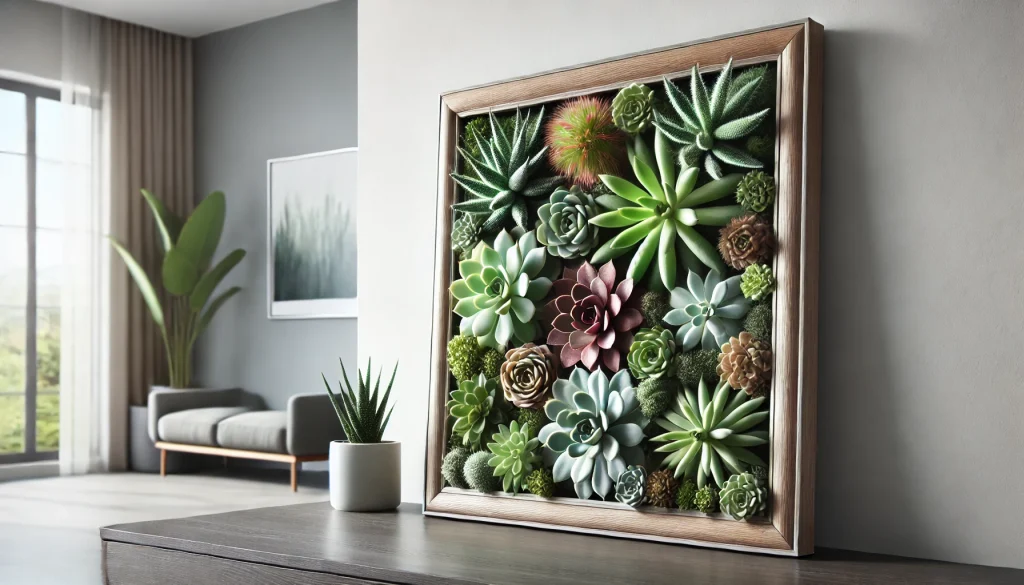
This creative setup involves using a deep picture frame filled with a succulent soil mix and covered with wire mesh.
Succulents are planted through the mesh, creating a living piece of art. This idea is perfect for adding a touch of greenery to indoor spaces.
3. Succulent Wall Planter
Professional living wall systems often feature built-in irrigation and are designed for outdoor or large indoor spaces. These systems can host a variety of succulents and are engineered to keep plants healthy with minimal maintenance.
4. Gutter Vertical Garden
Repurposing old gutters can create a unique vertical succulent garden. The gutters are mounted on a wall and filled with succulent soil and plants.
This method is great for narrow spaces and can often be seen in urban gardening setups.
5. Shoe Organizer Garden
A fabric shoe organizer can be repurposed into a vertical garden by filling its pockets with soil and succulents.
This creative idea is ideal for small spaces and is often featured in home improvement blogs.
6. Wooden Ladder Display
An old wooden ladder can be leaned against a wall and used to display a variety of potted succulents. This arrangement adds height and dimension to your garden space.
7. Living Succulent Wreath
Creating a living wreath using a wire frame and various succulent cuttings is a unique and eye-catching project.
This setup is versatile and can be used as a wall hanging or centerpiece.
8. Vertical Planter Boxes
Using stacked or wall-mounted planter boxes specifically designed for succulents can create a structured and neat vertical garden.
These boxes often have built-in drainage systems to keep the plants healthy. Retailers like Wayfair and Amazon offer various designs suitable for different spaces.
9. Repurposed Window Shutters
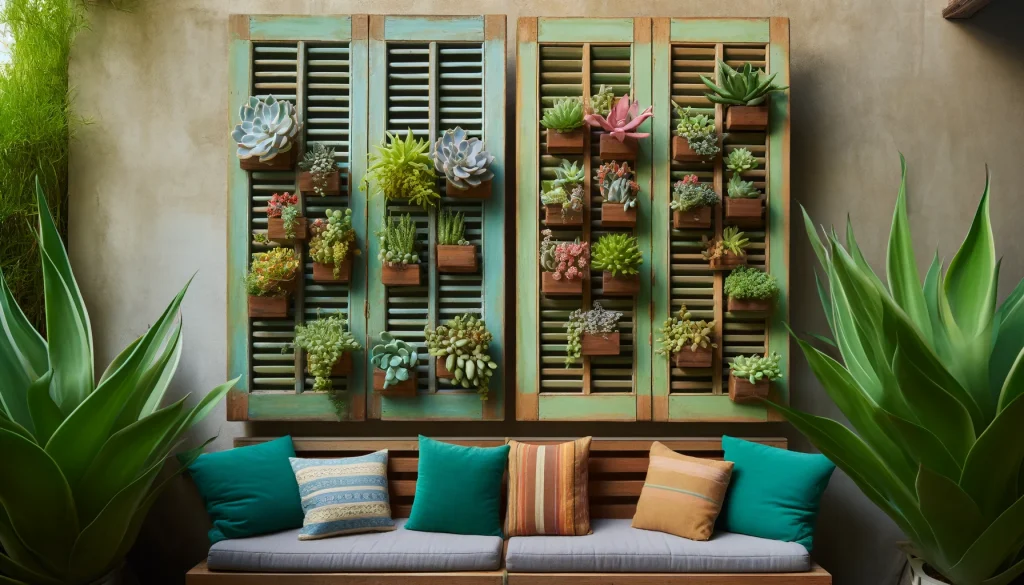
Old window shutters can be transformed into a charming vertical garden by attaching small containers for succulents.
This creative use of materials adds character and greenery to any outdoor space.
By exploring these successful vertical succulent garden setups, you can find inspiration and practical ideas to start or enhance your own vertical garden.
Whether you prefer DIY projects or professional installations, there’s a vertical gardening solution for every space and style.
8. Vertical Succulent Gardens FAQs
Let’s answer some common questions about vertical succulent gardens. These frequently asked questions will help you understand how to create and maintain a thriving vertical succulent garden.
Q: Can you grow succulents vertically?
A: Yes, with proper support and care, succulents can thrive in vertical gardens. They are well-suited for vertical arrangements due to their shallow root systems and ability to adapt to different growing conditions.
Q: How to water a vertical succulent garden?
A: Water sparingly, allowing the soil to dry between waterings to prevent root rot. Succulents store water in their leaves and stems, so they don’t need frequent watering. Ensure your vertical garden has good drainage to avoid waterlogging.
Q: What are the cons of vertical gardening?
A: Potential issues include soil erosion, maintenance challenges, and ensuring adequate water and light for all plants. Vertical gardens can also be more susceptible to environmental factors such as wind and temperature fluctuations.
Q: Are vertical gardens worth it?
A: Yes, they save space, improve air quality, and add beauty to your home. Vertical gardens are especially valuable in small living spaces where horizontal gardening isn’t an option. They also provide a unique way to display plants.
Q: How do you make a raised succulent garden?
A: Similar to vertical gardens, raised gardens need good soil, support, and drainage. Use a raised bed or container with well-draining soil and ensure it receives adequate sunlight. Arrange succulents to allow room for growth and airflow.
Q: What is the hardest succulent to grow?
A: Certain rare species of lithops can be challenging. These “Living Stones” require precise watering and light conditions to thrive, making them more difficult to care for compared to other succulents.
Q: Do succulents do better in soil or rocks?
A: Succulents thrive best in well-draining soil with some gravel for drainage. While they can grow in rocky environments, soil provides the necessary nutrients and stability for healthy root development.
Q: What is the most sought after succulent?
A: Rare varieties like “Living Stones” (Lithops) are highly prized among succulent enthusiasts. Their unique appearance and growth patterns make them a popular choice for collectors.
Q: What is the prettiest succulent?
A: Many find Echeveria and Aloe Vera to be among the most attractive. Echeverias are known for their colorful rosettes, while Aloe Vera has a striking form and medicinal properties.
Q: What is the most resilient succulent?
A: Jade Plant (Crassula ovata) and Aloe Vera are known for their toughness. They can withstand a variety of conditions and are relatively easy to care for, making them ideal for beginners.
Q: Do most succulents like full sun?
A: While many do, some prefer filtered light; it depends on the species. Echeverias and Sedums thrive in full sun, while Haworthias and Gasterias do better in partial shade.
Q: What is the slowest growing succulent?
A: Some cacti and certain species of Haworthia grow very slowly. These plants take several years to reach maturity, making them suitable for long-term projects.
Q: What is the longest living succulent?
A: With proper care, succulents like the Jade Plant can live for decades. They are known for their longevity and can become a lasting part of your garden.
Q: What is a hard succulent?
A: “Hard” succulents can withstand tough conditions, like many cacti. These plants are adapted to survive in harsh environments with minimal water and extreme temperatures.
By addressing these common questions, you can better understand how to care for your vertical succulent garden and ensure it remains healthy and vibrant.
Vertical Succulent Gardens Conclusion
Creating a vertical succulent garden is an enjoyable and rewarding project that can add beauty and greenery to any indoor or outdoor space.
Read More: Indoor Vertical Gardening: Start Your Indoor Garden Now
By carefully selecting the right plants, understanding their needs, and following the proper steps for planting and maintenance, you can cultivate a thriving vertical garden that brings joy and tranquility to your environment.
Here are some final thoughts and key takeaways to help you get started.
Choosing the Right Plants
Choosing the right succulents for your vertical garden is crucial for success.
Consider the light conditions, shapes, and textures of the plants to create a visually appealing and healthy garden.
Creative Vertical Garden Ideas
There are many creative ways to design your vertical succulent garden. From using old picture frames and shoe organizers to repurposing wooden pallets and ladders, the possibilities are endless.
Let your creativity shine and customize your garden to fit your style and space.
Maintaining Your Vertical Garden
Proper maintenance is essential to keep your vertical succulent garden thriving. Ensure adequate lighting, water sparingly, and keep an eye out for pests.
Regular pruning and cleaning will keep your garden looking its best.
Key Takeaways
- Select the Right Succulents: Choose plants that match the light conditions and space requirements of your garden.
- Creative Arrangements: Use innovative designs like pallet gardens, picture frames, and shoe organizers to create unique displays.
- Proper Planting Techniques: Prepare cuttings, use well-draining soil, and plant securely through wire mesh.
- Indoor and Outdoor Care: Adjust care routines based on whether your garden is indoors or outdoors, focusing on lighting, watering, and pest control.
- Regular Maintenance: Prune, clean, and monitor your garden to ensure it remains healthy and vibrant.
By following these tips and embracing your creativity, you can create a stunning vertical succulent garden that enhances your living space and brings a touch of nature into your home. Happy gardening!
Visit my Amazon Influencer Page for videos and gardening products Grow Your Own Garden

























